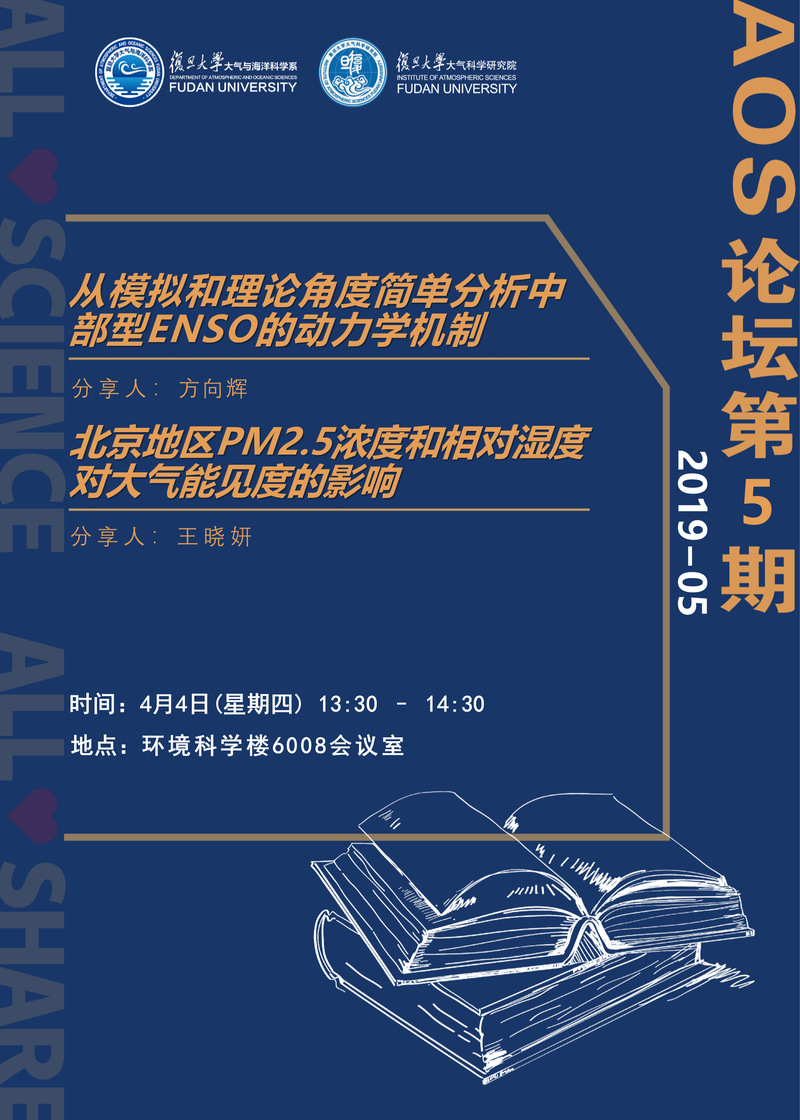
Title:A simulating and theoretical investigation on the dynamics of the central-Pacific type of ENSO (从模拟和理论角度简单分析中部型ENSO的动力学机制)
Xianghui Fang
Abstract:Severe biases exist in state-of-the-art general circulation models (GCMs) in capturing realistic central-Pacific (CP) El Niño structures. At the same time, many observational analyses have emphasized that thermocline (TH) feedback and zonal advective (ZA) feedback play dominant roles in the development of eastern-Pacific (EP) and CP ENSO (El Niño–Southern Oscillation), respectively. In this work, a simple linear air–sea coupled model, which can accurately depict the strength distribution of the TH and ZA feedbacks in the equatorial Pacific, is first used to investigate these two types of El Niño. Next, a three-region conceptual model for central Pacific El Niño including ZA feedback is constructed. The simple zonal two-region framework of the recharge paradigm can accurately manifest the traditional EP ENSO, as its major warming center is located in the EP and the anomalous sea surface temperature (SST) changes monotonically from west to east along the equatorial Pacific. However, it cannot fully depict the variations of the CP ENSO. Therefore, to better investigate the characteristics of the CP ENSO, the recharge paradigm is extended to a three-region conceptual model to describe the entire western, central and eastern equatorial Pacific.
Title: The effects of PM2.5 concentrations and relative humidity on atmospheric visibility in Beijing(北京地区PM2.5浓度和相对湿度对大气能见度的影响)
Xiaoyan Wang
Abstract: Atmospheric visibility is often used as a proxy for ambient air quality. However, in addition to the concentrations of particulate matter, visibility is also affected by meteorological conditions. The relative contributions of PM2.5 concentrations and meteorological conditions to visibility are not yet clear. In this study, the individual contributions of PM2.5 concentrations and the relative humidity (RH) to the visibility are measured based on observations at 12 stations in Beijing. We find that visibility decreases quickly as PM2.5 concentrations increase at low PM2.5 concentrations and decreases slowly when PM2.5 concentrations exceed 100 µg/m3. The visibility decreases linearly as PM2.5 concentrations increase when the PM2.5 concentrations are below 50 µg/m3; however, there tends to be an exponential relationship as the PM2.5 concentrations increase. The PM2.5 concentrations can explain 50% of the variance in visibility in clean and high-humidity environments, whereas this fraction decreases to 10-15% when the PM2.5 concentrations exceed 200 µg/m3. In contrast, RH has little effect on visibility under dry conditions. When the RH exceeds 40%, atmospheric visibility tends to display an inversely proportional and exponential relationship with RH under polluted and clean conditions, respectively. Under high-humidity and highly polluted conditions, up to 40% of the variance in visibility is associated with RH. The PM2.5 concentrations dominate the variations in visibility under dry or low-PM2.5 concentrations, and the contributions of RH become increasingly important as the PM2.5 concentrations and humidity increase. This study emphasizes the atmospheric conditions when employing visibility as a proxy for air pollution.